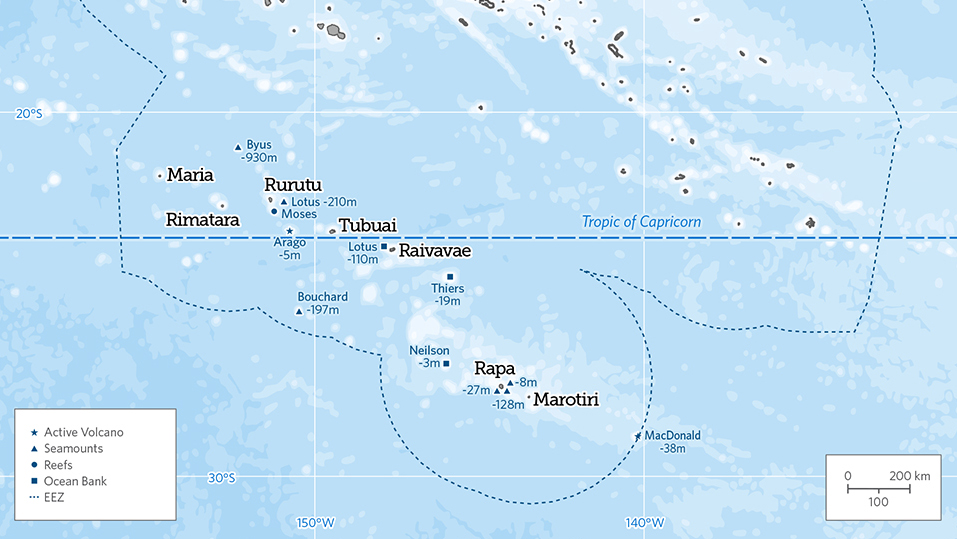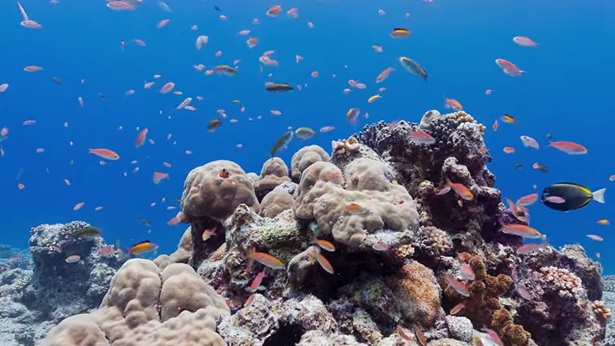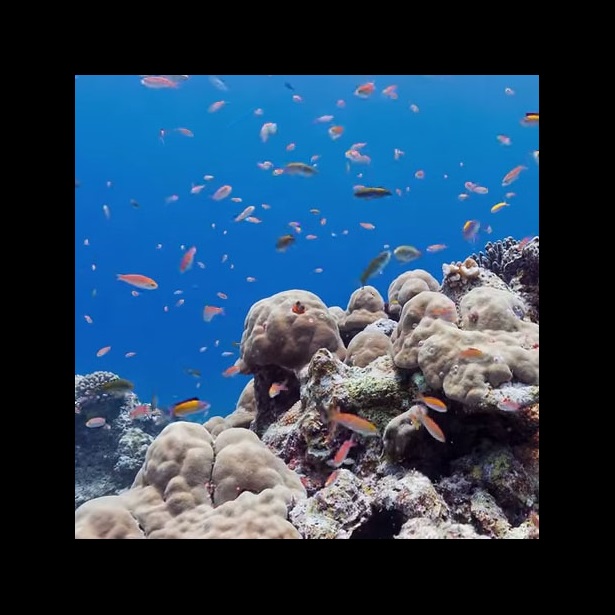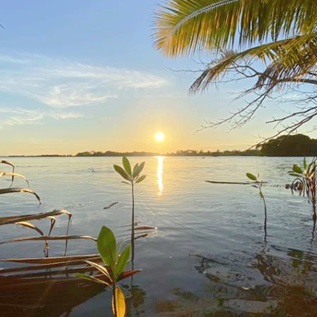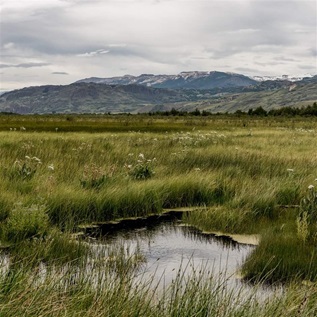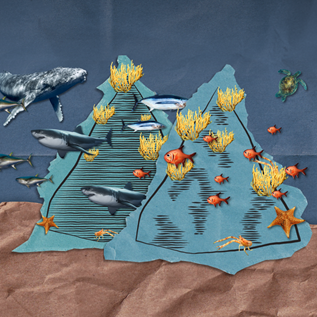A Scientific Review of French Polynesia's Austral Islands
An overview
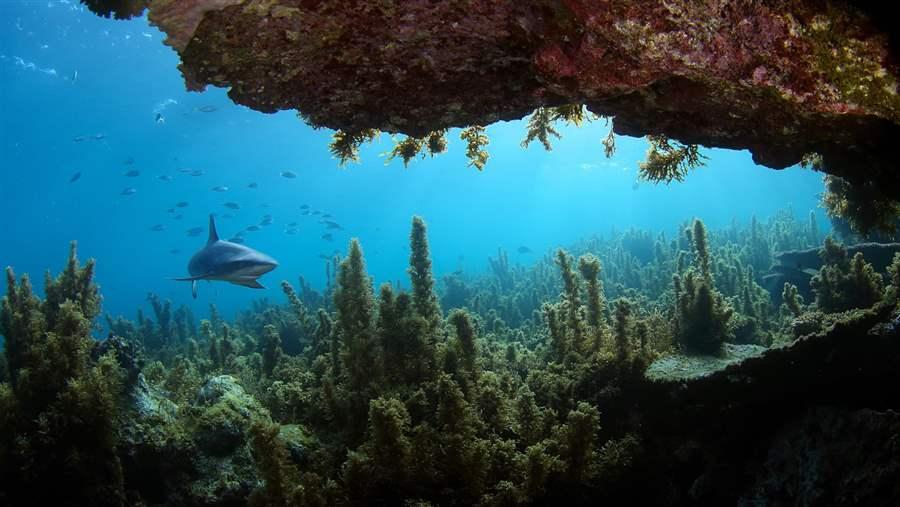 Manu San Felix
Manu San Felix
The underwater marine ecosystem off Rapa, one of the Austral Islands.
In November 2013, French Polynesia’s government committed to protecting at least 20 percent of the French territory’s waters by 2020. More than 50 local organizations voiced support for this goal at a June 2014 event celebrating the local visit of the Hokule’a—the traditional Polynesian vessel and its crew that stopped in Tahiti as part of its travels from Hawaii across the Pacific to promote ocean protection.
The Austral Islands, the southernmost archipelago in French Polynesia, present a great opportunity for conservation. They benefit from extraordinarily rich marine ecosystems, and their people have long sought to protect their environmental legacy. In 2014, municipal councils of the five inhabited islands called for the creation of a large marine protected area (MPA) surrounding the Australs. The government listened and announced in November at the World Parks Congress in Sydney that it intended to establish a large MPA in those waters.
Earlier that year, French Polynesia invited The Pew Charitable Trusts to conduct a detailed scientific inventory of the Austral Islands’ marine environment and examine the relationship between the islands and life in the surrounding waters. This interdisciplinary report is the result, produced with input from a wide range of experts. It is intended to serve as a foundation of knowledge to help define the conservation measures that the government and local communities will consider.
Austral Islands
Methodology
The Institute for Pacific Coral Reefs (IRCP) at the Insular Research Center and Environment Observatory (CRIOBE) in Moorea managed the work for this Pew-supported report. Thirty issue experts from research centers, universities, government offices, and environmental groups were asked to write sections based on their areas of expertise. The report ends with a summary highlighting the main themes.
Four field expeditions helped supplement the data available in the scientific literature. Those trips included a biological inventory in the waters surrounding the islands of Rapa and Marotiri that was organized by the National Geographic Society; an excursion led by the Auckland Museum of New Zealand that focused on the marine life of the southern islands of French Polynesia, including Rapa and Marotiri; another organized by the French Polynesia Department of Culture and Heritage to analyze ties between the people and the ocean, and a mission to study marine mammals led by the PROGEM (Protection et Gestion des Ecosystèmes Marins) consultancy and the French Polynesia Directorate of the Environment. The authors and others discussed the findings at a conference in Papeete on Feb. 18, 2015.
Ecological aspects of the Australs’ marine environment
The waters surrounding the Austral Islands teem with a remarkable diversity of life, including many species found nowhere else. The diversity of island topographies encompasses recently formed volcanic islands without lagoons, such as Rapa and Marotiri; islands with large lagoons, such as Tubuai and Raivavae; the Maria atoll; and the coral islands of Rurutu and Rimatara, which were raised in the second of two periods of volcanic activity.
The environment differs from other island groups in French Polynesia because of these varied characteristics and the Austral climate—between a tropical zone and a temperate one. The marine environment is more closely aligned, however, with the Cook Islands to the west or Pitcairn to the east. The Australs’ relative isolation has led to a high number of unique species, especially among mollusks, fish, coral, and algae. There are, for example, 455 species of mollusk in the Austral Islands; more than 20 percent—98 species—are endemic.
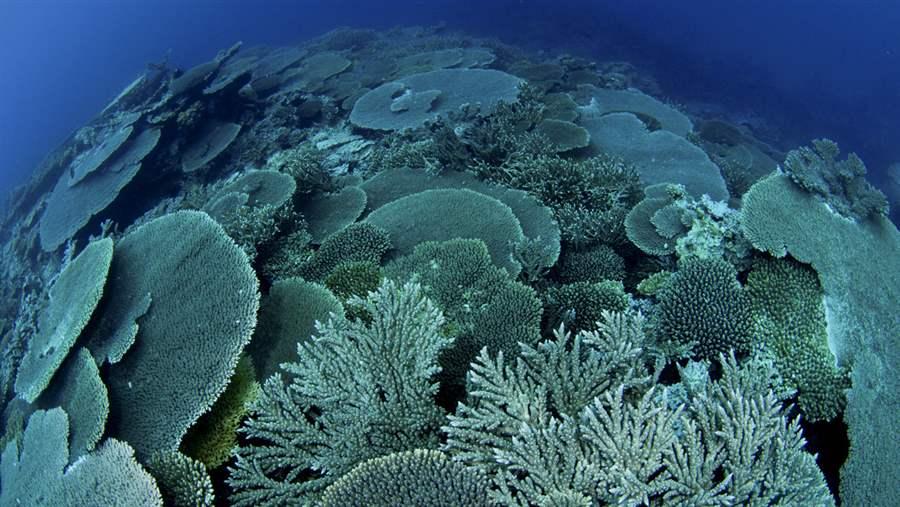 Ian Skipworth
Ian SkipworthCoral reefs in Rapa, Austral Islands.
The island of Rapa is a hot spot of marine biodiversity, with 112 coral species out of the 170 in all of French Polynesia, as well as 250 species of mollusks and 383 species of coastal fish—10 percent of which are endemic to the island. Researchers have identified more than 60 pelagic fish species and 45 deepwater fish species to date. And the healthy supply of phytoplankton in these waters is vitally important to the food web.
An abundance of swordfish, marlin, and opah live in the waters around Rapa. Target species for deep-sea fishing, such as tuna and swordfish, are well preserved, thanks to limited fishing pressure. There is virtually no fishing south of the islands, where the waters are home to a range of well-known fauna, including several species of sea turtles, 10 species of marine mammals, 14 species of sharks, and four species of rays. These include the Galapagos shark, found in French Polynesia only off the Austral and Gambier islands, humpback whales that appear annually off the coast, and green turtles, whose nesting sites have been identified on several islands. The archipelago also has the most diverse assemblage of marine birds in French Polynesia, including 23 of the territory’s 28 breeding species.
The 2014 scientific expeditions to Rapa and Marotiri confirmed the high level of endemic flora and fauna, but a precise measure of the archipelago’s full richness awaits further exploration of the marine environment of the five northern islands and the 42 underwater seamounts. What scientists have learned to this point, however, testifies to the unique and rich biodiversity in these waters. In addition, the relative isolation of the southern archipelago, the number of unique species, and their level of preservation makes this a valuable site to observe the impacts of a changing climate.
Cultural aspects of the Austral Islands’ marine legacy
The cultural heritage of the Austral Islands is intertwined with the ocean. Iconic species—sea turtles, sharks, and whales, for example—play central roles in the creation stories of island communities and help define the relationships among society, culture, and the environment. This heritage is reflected in the names given to lagoons, landmasses, and reefs.
According to local lore, Raivavae is associated with a whale, while Tubuai represents the head of an octopus, and five other islands represent tentacles. And the natural surroundings are integrated into the stories of a community, a tribe, or an island. For instance, a whale or a shark may appear in these legends to help a lost traveler.
This tradition is testament to a vision of how the ocean is tied to families, peoples, and the Pacific region as a whole. It also connects the local population to New Zealand, the Cook Islands, and the Society Islands.
The arrival of Europeans at the end of the 18th century and the interactions that followed entailed religious, political, and economic aspects that influenced and at times disrupted the social structures of the Austral Islands. But contact with the Europeans did not end the close relationship of the indigenous people with the ocean, which remains an integral part of their lives.
Residents of the Australs understand the importance of their island culture and in recent decades launched efforts to restore practices long abandoned that link their culture and their environment. This led to a resurgence in the use of the rahui, the temporary ban on the use of a resource or a territory, initially in Rapa, and later in Rimatara and Rurutu.
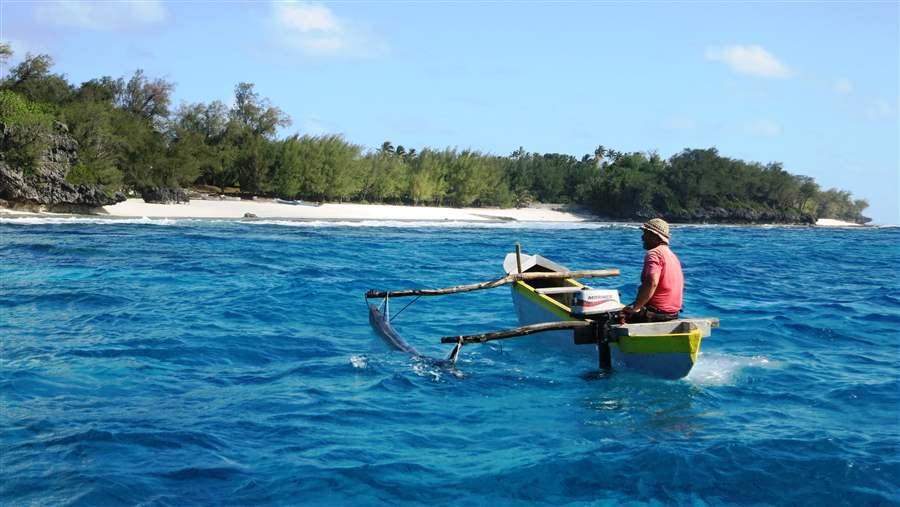 Jérôme Petit
Jérôme PetitLocal fisherman in a traditional canoe off Rimatara.
In Rapa, traditional Polynesian customs inspired reintroduction of the marine rahui in the 1980s. Leaders adjusted the process somewhat to reflect more modern times, as well as social and environmental needs. For example, the ban on fishing on the east coast of the island is permanent, rather than cyclical or on a rotation. Firmly anchored in tradition, the Rapa rahui seems well suited to manage the island’s marine resources. Establishing a new rahui proved difficult at first, but the people of Rapa are now overwhelmingly satisfied and proud of this unique management method. They hope it serves as a model for other island communities.
The ethnological studies undertaken by CRIOBE, the Department of Culture and Heritage, the IRD (Institut de Recherche pour le Développement), and Pew confirm the richness of the Australs’ cultural heritage and the importance of the relationship between the people and the ocean (Moana). The findings also affirm traditions that call for local populations to play a role in facing the challenges associated with preservation (paruru) of their ocean. The research underscores the need to better understand the links among these traditions and those of different island groups, most notably the Cook Islands.
Socio-economic challenges
Though government and agriculture are the main drivers of the local economy, coastal and lagoon fishing also contribute significantly. About 50 people fish professionally; another 1,600 nonprofessionals fish regularly. Local use of what is created or harvested on the islands or from their waters—most notably for agriculture, fishing, and crafts—is essential to the Australs’ economy.
Tubuai and Raivavae have vast lagoons conducive to reef fishing and clamming. Rurutu, Rimatara, and Rapa, meanwhile, have more diverse fisheries that include healthy populations of reef and deepwater invertebrates. Still, the Australs’ abundant pelagic life remains largely preserved, despite encroaching pressures from international fisheries beyond the exclusive economic zone (EEZ). Even with the relative abundance of albacore, marlin, and swordfish, the Polynesian fishery is not well developed for a variety of reasons, including weather conditions, the absence of a safe harbor for boats south of the 20th parallel in case of emergency, and the relative isolation that makes commercial fishing less cost-effective. Still, foreign vessels seeking albacore and swordfish fish just outside the southern outskirts of the EEZ at certain times of the year.
Among the conclusions are that conservation of Rapa and Marotiri must be top priorities because of the nature and uniqueness of the species found there—on land, in the air, and in the water.
Ecotourism in the Australs, on the other hand, is increasingly attracting foreign visitors. Humpback whale watching is booming, especially from Rurutu. A whale watching expedition led by PROGEM in September 2014 helped produce an inventory of marine mammals. It also provided ideas for crafting regulations on approaching whales to avoid excessive pressure on the animals and to ensure their sustainability. In Raivavae, an ecotourism association places tourists in the homes of local families, giving them an opportunity to learn about the island way of life and local traditions.
Pressures on the marine environment often harm critical coral reefs, which can be damaged by natural disturbances such as cyclones and infestations of coral-eating starfish. Humans add to the problems with excavations to create embankments that accommodate marine ports and channels. Fishing along the coasts and reefs remains important to the local economy and appears to have only a moderate environmental impact.
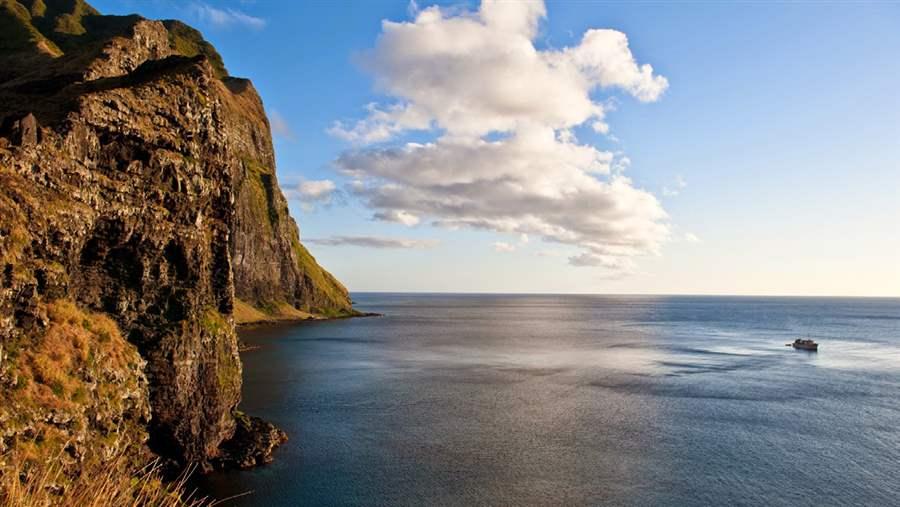 Ian Skipworth
Ian SkipworthCliffs in Rapa.
Key interests on each island
The inventory brings into focus the intersection of ecological interests and socio-economic challenges facing individual islands. Included in this report is a synthesis of key interests and issues, ranked in order of priority using a matrix of scores for each island based on multiple criteria. Among these are the geomorphology, or the lay of the land and ocean floor; the populations of marine life such as corals and coastal fish, and the opportunities for fishing and tourism.
The hierarchy can help identify conservation issues and management priorities.
Among the conclusions are that conservation of Rapa and Marotiri must be top priorities because of the nature and uniqueness of the species found there—on land, in the air, and in the water.
Rurutu and Tubuai present the most significant socio-economic challenges because they have the highest human population density per square kilometer of reef, the greatest amount of lagoon and coastal fishing, and the strongest pressures on marine resources caused by coastline and agricultural activities, such as fishing. They will require the most significant efforts to manage pressures on their marine environments. The ecology of Raivavae and Rimatara presents more moderate challenges.
Finally, the uninhabited rocks of Marotiri and the Maria atoll see relatively little human impact on marine resources, and their natural environments remain rich and well preserved. They present true opportunities for conservation.
Among the report’s key findings:
- Rapa and the rocks of Marotiri sit on the border of the tropical zone and are therefore subject to somewhat different hydro-climatic conditions than are the other islands. Their conservation is important because of their rich coastal biodiversity, high level of endemism, diverse and abundant pelagic fauna, and unique reef communities. Rapa’s culture is also of critical interest. Leaders reintroduced the concept of rahui about 30 years ago to manage marine resources in a collective and long-lasting way. Today, Rapa’s rahui is central to the local culture, and its impact reverberates throughout French Polynesia.
- Raivavae’s marine environment features a large lagoon, a significant clam population, and a wide variety of reef and lagoon species. It has many birds, including 14 breeding species on the International Union for Conservation of Nature Red List. The island’s well-preserved cultural and natural heritage makes it a natural site for development of ecotourism.
- Tubuai’s waters are of significant ecological interest but present important socio-economic challenges. This island has the richest coral fauna in the archipelago and a remarkable diversity of fish because of its large lagoon. It has a large natural stock of clams as well, estimated in the range of 50 million. That means fishing for clams has become more important to the local economy. The Tubuai islets known as motus, meanwhile, offer land bridges for green sea turtles. Fearful of a decline in marine resources, many fishermen would like to see the re-establishment of a rahui system to preserve fish and clam stocks.
- Rurutu is distinguished by its Makatea-like geomorphology—a lifted atoll—with cliffs 70 meters high fringed by a narrow reef. It has the highest concentration of marine mammals and sharks in the Australs. Whale watching has become an engine of ecotourism growth, with about 1,000 visitors annually. Fishing of coastal resources creates more pressure on the environment than in the other Austral islands because of the smaller reef area and greater human population.
- Rimatara features a small reef lagoon. The island has stronger geographic, cultural, and traditional links to the Cook Islands because of its location. Like the other islands, its cultural heritage is closely linked to the ocean.
- The Maria atoll, in the far west of the archipelago, is distinguished by its geomorphological characteristics and the life in its reefs and lagoon. It is the only atoll in the Australs and the southernmost atoll in French Polynesia. This uninhabited island’s waters are a conservation haven because there is virtually no pelagic fishing. Its location also makes Maria a cultural and geographic link between the Austral and the Cook Islands.
- Finally, the vast ocean expanse surrounding the archipelago includes 42 seamounts, which provide habitats for remarkable biodiversity. As elsewhere in the region’s waters, that means a high rate of fish and invertebrates found nowhere else. Pelagic species also are abundant. Longline fishing is practically nonexistent, though local fishermen occasionally exploit certain shallows near inhabited islands.
Conclusion
This report offers an initial balance sheet of the marine environment of the Australs. Using a multidisciplinary and cross-disciplinary approach, the authors describe the natural marine environment of these islands, as well as the ties between their people and the surrounding seas.
The work confirms that the Austral archipelago, with a total ocean area of about 1 million square kilometers, differs from other island strings in French Polynesia and benefits from the many species unique to its waters, the well-preserved state of its marine environment, and the strong links between the local culture and the ocean. Each island has its own characteristics connected to its natural resources and cultural identity, but the archipelago as a whole offers a strong conservation opportunity.
Following the call by the Austral councils and the pledge of the government to work toward creation of a marine protected area, this report can help define a conservation strategy. The data provide a knowledge base as the people of the Australs consider a plan to address local needs and realities. Now comes the task of establishing long-lasting management measures for conservation of these vital waters.
We are convinced that creating a worldwide system of very large, fully protected marine reserves is an essential and long-overdue step that will significantly improve stewardship of the global marine environment.
For further information, please visit: globaloceanlegacy.org
